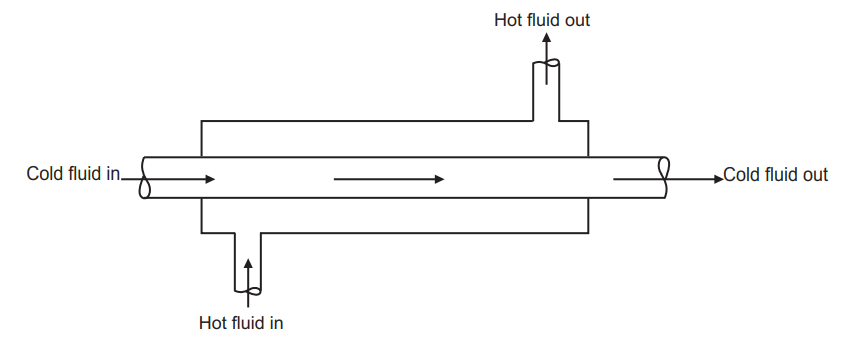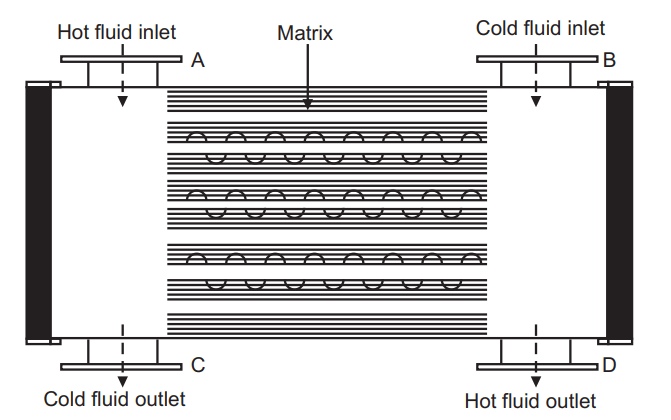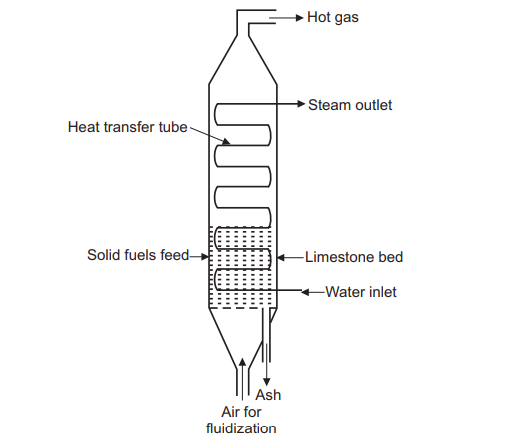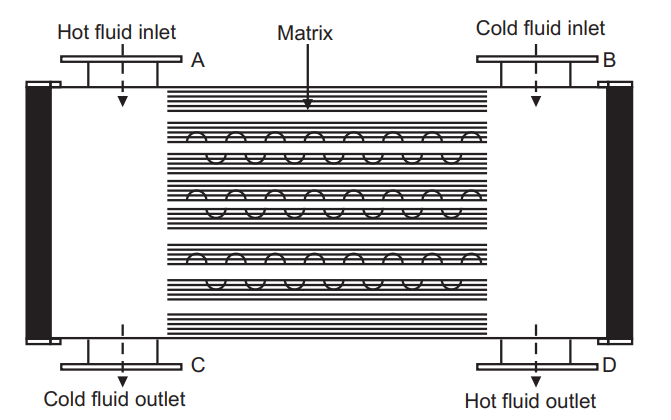The fluid streams remain separate in an indirect-contact heat exchanger, and heat is transferred constantly through a separating wall or into and out of a wall. Thermally interacting fluids do not come into direct touch. Surface heat exchangers are another name for this type of heat exchanger. Direct-transfer heat exchangers, storage heat exchangers, and fluidized-bed heat exchangers are the three types of heat exchangers detailed below.
Table of Contents
(a) Direct-transfer type exchangers
Heat is continually transferred from the heated fluid to the cold fluid through a dividing wall in this type (Fig. 4.8). Although the exchanger requires the simultaneous flow of two fluids, there is no direct mixing of the fluids because each fluid runs through its own fluid path. In most of these heat exchangers, there are no moving parts. A recuperative heat exchanger, or simply a recuperator, is the name given to this type of exchanger. A recuperator is a type of heat exchanger that uses waste gases to heat air.

Tubular, plate-type and extended surface exchangers are examples of direct transfer heat exchangers. Shell-and-tube and plate heat exchangers are not typically referred to as recuperators in the process sector, but they are nonetheless considered recuperators. Prime surface exchangers and extended-surface exchangers are two types of recuperators. Fins or expanded surfaces on any fluid side are not used in prime surface exchangers. Prime surface exchangers include tubular exchangers, shell-and-tube exchangers with plain tubes, and plate exchangers.
(b) Storage type exchangers
Both fluids alternately flow through the same flow passages in a storage type exchanger (Fig. 4.9), resulting in intermittent heat transfer. The heat transfer surface is either a permeable solid material, referred to as a packed bed, or a cellular structure, referred to as a matrix. When hot gas passes over the heat transfer surface, its thermal energy is retained in the matrix wall, allowing the hot gas to cool during the matrix heating time. The matrix wall gives up thermal energy as cold gas runs through the same passageways later, which is absorbed by the cold fluid. As a result, unlike a direct-transfer type exchanger, heat is not carried continuously through the wall, but the corresponding thermal energy is alternatively stored and released by the matrix wall. This storage type heat exchanger is also referred to as a regenerative heat exchanger, or simply as a regenerator.

To operate continuously and within a desired temperature range, the gases, headers, or matrices are switched periodically so that the same passage is used for hot and cold gases. The actual time required for hot gas to flow through a cold regenerator matrix is called the hot period or hot blow. Whereas the time required for cold gas to flow through the hot regenerator matrix is called the cold period or cold blow. It is not necessary to have hot- and cold-gas flow periods of equal duration. There is some unavoidable carryover of a small fraction of the fluid remaining in the passage to the other fluid stream after switching of the fluids; this is known as carryover leakage. If the hot and cold fluids are at different pressures, the leakage is from the high-pressure fluid to the low-pressure fluid past the radial, peripheral, and axial seals, or across the valves, referred to as pressure leakage. These leakages being unavoidable, regenerators are used exclusively in gas-to-gas heat and mass transfer applications with sensible heat transfer. In some applications, regenerators may transfer about 5% moisture from humid air to dry air.
(c) Fluidized-bed heat exchangers:
In a fluidized-bed heat exchanger, one side of a two-fluid exchanger is immersed in a bed of finely divided solid material, as shown in Fig. 4.10. If the upward fluid velocity on the bedside is low, the solid particles will remain fixed in position in the bed and the fluid will flow through the interstices of the bed. If the upward fluid velocity is high, the solid particles will be carried away with the fluid. At a ‘‘proper’’ value of the fluid velocity, the upward drag force is slightly higher than the weight of the bed particles. This causes the solid particles to float with dilation of bed behave as a liquid and is referred to as a fluidized condition. In this condition, the fluid pressure drop through the bed remains almost constant, independent of the flow rate, and a strong mixing of the solid particles occurs. This causes uniform temperature in the whole bed with an apparent thermal conductivity of the solid particles as infinity.

When compared to particle-free or dilute-phase particle gas, the fluidized side achieves extremely high heat transfer coefficients. In many industrial applications, chemical reactions occur on the fluidized side, and combustion occurs in coal combustion fluidized beds. The fluidized-bed heat exchanger is used for drying, mixing, adsorption, reactor engineering, coal combustion, and waste heat recovery, among other things. The initial temperature difference between the hot fluid’s inlet temperature and the fluidized bed is reduced by fluidization, lowering the exchanger’s efficacy.
Direct-Contact Heat Exchangers
Two fluid streams come into direct contact in a direct-contact exchanger, exchange heat, and then are separated. Mass and heat transfer are common applications for direct-contact exchangers, such as evaporative cooling and rectification. In such an exchanger, the enthalpy of phase transition accounts for a large fraction of the total energy transfer. The heat transfer rate is often improved by the phase change. Due to the lack of a heat transfer surface between the two fluids, direct-contact heat exchangers offer very high heat transfer rates, exchanger construction is relatively affordable, and fouling is generally non-existent. The following is a list of the different types of exchangers.
(a) Immiscible Fluid Exchangers:
(i) Liquid-liquid exchanger:
In this type, two immiscible fluid streams are brought into direct contact. These fluids may be single-phase fluids, or they may involve condensation or vaporization. For example, condensation of organic vapours and oil vapours with water or air.
(ii) Gas–liquid exchangers:
In this type, one fluid is a gas and the other a low-pressure liquid (commonly, water) and is readily separable after the energy exchange. In either cooling of liquid (water) or humidification of gas (air) applications, liquid partially evaporates and the vapour is carried away with the gas. In these exchanges, more than 90% of the energy transfer is by virtue of mass transfer due to the evaporation of the liquid and convective heat transfer is a minor mechanism. For example, water cooling tower with forced- or natural-draft airflow, air-conditioning spray chamber, spray drier, spray tower, and spray pond.
(b) Liquid–Vapour Exchangers:
In this type, steam is partially or fully condensed using cooling water, or water is heated with waste steam through direct contact in the exchanger. Non-condensable and residual steam and hot water are the outlet streams. For example, de-superheaters and open feed water heaters (de-aeraters) in power plants.
Make sure check our amazing article on: Applications of heat exchangers
